| Foreword | Contents | Acknowledgements | Introduction | Updates | Stationery |
Initially the prices quoted were Hiscocks' original 1982 prices in British Currency (£).
Prices are mostly updated now and the currency is selectable at the top of pages.
| Steve Lawrie collection The Steve Lawrie Private Telegraph collection has mostly been sold. (28 October, 2020) A downloadable PDF catalogue is available at GrosvenorAuctions.com, as well as prices realised.. This website owes a great debt to Steve Lawrie for making images of his collection available to the world. A great thank you also to Ian Pinwill, who facilitated that by much travel and endless hours spent scanning them. . |
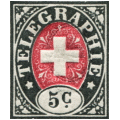 |
| Rest of World |
Steve Hiscocks wrote:
As in many developed countries the British telegraph system was started by the railway companies who were able to set up lines on their own land.
While these lines were initially for their own use the railway companies soon saw that money could be made by allowing public access. Success
was immediate and between 1846 and the early 1860s a dozen or more companies were set up to exploit these and later systems set up along
roads, etc. in 1868 an Act of Parliament (the Telegraph Act) was passed allowing the Postmaster-General to purchase the assets of the inland
telegraph companies and in 1869 and 1870 this was done.
Brief information on the stamp-issuing private companies is given above the corresponding listings and background information on the later, GPO,
telegraph stamps and on the military telegraph stamps will also be found in the appropriate sections.
I have gradually extended his work into areas precluded by the restrictions of a bound publication.
| 1 | Books are expensive, especially if they have limited appeal. Shipping them can also expensive. |
| 2 | Books have illustrations in Halftone so you cannot see details. |
| 3 | Books have most illustrations in glorious monochrome. |
| 4 | Books are frozen in time, they do not update. |
| 5 | Books cannot use online translation or currency conversion. |
Having said that, I have also been involved in the production of some printed publications as I know that not everyone uses the internet.
 and the T.O. series
and the T.O. series 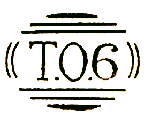 .
.
| There is a book 'TELEGRAPH and TELEPHONE Stamps of the World, a Priced and Annotated Catalogue' by S.E.R Hiscocks (1982) that I have used for information and catalogue designations, copies are in short supply. If you want it, try the link above and if none are available at a reasonable price, try the link "Tell the Publisher! I’d like to read this book on Kindle" if enough people do it might be made available electronically. I have also recently been shown a book by Philbrick & Westoby (1881) called "The Postage and Telegraph Stamps of Great Britain" which seems to be a source of much information, though be warned, perforations seem to be rounded to the nearest whole number. It is available from philatelicsannex.org under 'P'. Other useful early works can be obtained on CD from J-and-H-Books More recently www.123pricecheck.com has been brought to my attention. Well worth searching. Hiscocks explicitly allows his designations to be used by others, so I quote them here. In some areas though, new discoveries require an extension of his work. I have no authority or inclination to 'revise' his system, so I have introduced a compatible system based on it that can be dynamically extended. Please see my Policy Statement for further details. |
The index at the top of each page shows the sections that the Telegraph part of my website is divided into.
Though history has never been one of my strong points, I feel a bit of background is warranted regarding these different companies.
The early days of the telegraphs is a time of fierce competition between companies as they sought to extend their reach and market share.
New companies formed, companies merged and companies disappeared.
Not all of them used stamps for accounting purposes, indeed some companies only provided the 'hardware'
leaving other companies to make use of them for profit. Here I will only try to show a brief family tree,
for a more in-depth treatment by someone much better equipped than I to do it, I recommend Distant Writing by (the late) Steven Roberts.
Another site worth a look is Atlantic-Cable.com.
| John Barefoot has recently published "TELEGRAPH STAMPS of the WORLD", an update to Hiscocks' book. Price was £30.00 + postage but is now sold out. He says: "In the catalogue, virtually all items are illustrated in full colour, some sections much expanded since Hiscocks, with up-to-date pricing for mint and for used. 140 pages. ISBN 0-906845-70-X" Telegraph Stamps of the World He is planning to release a new edition soon. We do exchange information, so it should have many updates. . |
The Site-Map is a good place to look for what you want. |
Take a break. I spend many hours at the computer. Occasionally I come across things that I would like to share. I thought I would add a small box giving some non-stamp links that some people may find a welcome diversion: According to a wiki: In the year 1746 the French scientist and religioso Jean Antoine Nollet gathered approximately 200 monks in a circle about a mile (1.6 km) in circumference, connecting them with pieces of iron wire. Nollet then discharged a battery of Leyden bottles through the human chain and observed that each reacted almost simultaneously to the electric discharge, demonstrating that the speed of electricity propagation was very high. Calendars for years from 1700 Fournier's Forgeries Ocean Winnowers Only Spacetime When I was at school (many decades ago), I was always into science. History and English were really not "my thing". Times change. When you start writing websites, rubbish spelling looks really unprofessional. I have gradually improved, but along the way I have noticed that many authors appear to have no qualms about "rubbish spelling". Even cofusion between "to" and "too", or between "of" and "off". I put together this "crib sheet" to highlight differences between often-confused words. . |
Yes, I know it may be a pain looking for updates in whatever interests you, but for me there may be many minor updates in well over 100, mostly foreign pages on this site.
It is imprictical to list all on a regular basis. But hey, if you have particular interests then why not get involved?
Involvement is a sure way to know what is going on.
| 2025 | |
|---|---|
| 27 July | EIM. I have added quite a few 1/6d images and 2/6d images, as well as some 4/- images. I have also split the 4/- into tw different plates. The first is rare, you need to know about it.. |
| 2024 | |
| 2024 | PO Stationery. The days may drag, but the years fly by. I added a lo of statioery, as well as (mostly) expanding the foreign section. |
| 2023 | |
| 20 September | PO Stationery. I have tabulated Anglo-American, Direct Spanish and Reuter's. Image added to Imperial & International. |
| 6 September | PO Stat. I have tabulated what I term the Imperial Evolution, from Imperial Cables, through Imperial Wireless and Imperial & International Communications to Cable & Wireless. |
| July 6th | PO Stationery - New section added to include non-PO forms that are not the earlier Private companies either. This was done to accomodate the new Griffiths entry. |
| July 6th | UK Electric - New receiving form added and Memorandum form added. Both relate to the new use of Hughes Machines. |
| 2 June | Site-map. has been updated to include Hippisley.html which links from Army Telegraphs 2. It has existed for a few years, but probably went unnoticed. |
| 9 March | TRANSLATION RE-IMPLEMENTED IN THIS SECTION USING GOOGLE - Thanks Bill. |
| 2022 | |
| November | PO Stationery. has been supplemented by pages for Unstamped Forms from Ian Pinwill and Edward Coombes, and Stamped "Kings" Forms from David Huggins. |
| August 16th. | This Page - brought up to date a bit. |
| August 15th. | Bonelli's - images added for the year on the watermark of 9d and 1s, a different orientation to the 3d and 6d. Watermark reconstruction added. |
| August 10th. | Intelligence Dept. added as an adjunct to Unexpected - This has been languishing for a while, looking for a home. |
| August 9th. | PO Stationery. split off from PO - This is in anticipation of an expansion of the Post Office Stationery section. |
| August 3rd. | S.E.R. and SER_Research - Updated after images of 9d, 1s and 1s6d used on same day, 4 April 1865. Progress on 1s sheet layout. |
| June | General Telegraph - An image of a company envelope with their address of 9, John Street, Adelphi, London. |
| 2021 | |
| June | Electric Telegraph - An image of most of the 'T.H.SAUNDERS' watermark has been added, as well as a section on the RG / HW 1s substituted clichés. |
| 2020 | |
| Oct. 5th | General Telegraph - Another image, now 7 examples. |
| September | Electric Telegraph and other Private telegraphs - A complete update from Lawrie collection, of the sections on Stationery and a new page created ET-forms.html. |
| August | Electric Telegraph - A complete re-write of the section on Stationery and a Tariff section added (thanks Ed). Also a couple of additions to the Message Papers. |
| July 1st. | Railway Telegraph Number List - This list of Railway Telegraph numbers that is sortable and searchable, has had extensive additions, but still has a long way to go. |
| March 11th | British & Irish - A new stamp! "One Shilling & Six Pence" with black control number. I also rearranged things a bit at the beginning for clarity. |
| 2019 | |
| April 21st | Universal Private Tel. - Finally showing the complete watermark, I actually started the image about a year ago, but got sidetracked. |
| April 2nd | English & Irish - Finished some major updates on the way things were arranged, especially the Plating Sections. |
| 2018 | |
| May 22nd | Electric Telegraph - Information added for the Perkins, Bacon printings taken from the 1927 book by E. D. Bacon regarding the plate constructions and printings. |
| May 21st | National Telephone - Further information and a few images added. |
| May 18th | British & Irish - Extensive updates including rare images of RH1 and RH22a. Also a new control forgery type and plating updates, particularly on high values. |
| May 7th | Electric Telegraph - Important images added. Now has the set of 7 Message Papers, a Continental 3d, and added 5/- and 10/- JSF images. |
| 2017 | |
| Dec. 17th | This page - I have added links at the top to newly created pages for Foreword, Contents, Acknowledgements and Introduction pages. |
| Dec. 16th | Army Telegraphs 2 - Updates, corrections and checklist added. |
| Sept. 3rd | CheckList Setup - The checklist project is maturing, feedback appreciated. |
| 2016 | |
| Oct. 5th | General Telegraph - Another image, now 6 examples. |
| 2015 | |
| Oct. 20th | Railway - With help from friends, the table at the top now has a link to a page with a list of Railway Telegraph numbers that is sortable and searchable. |
| Oct.6-8 | Updates from the Langmead & Huggins book to British & Irish, English & Irish, Electric Telegraph, Bonelli's, S. E. R., UK Electric, B. T. C. & PO. |
| Oct. 5th | General Telegraph - More updates, now 5 examples. |
| Oct. 5th | London District - Images added from the Langmead & Huggins book, courtesy of the Great Britain Philatelic Society. Updates to manuscript control info. |
| September | English & Irish - Many updates including a new discovery, division into 3 groups and a start on plating. |
| June. 22nd | London, Chatham and Dover Railway - Significant updates including a new image of a yellow 1s added. |
| June | Current prices have now been added with selectable currencies. |
| Jan. 14th | PO-Perfins - 22 new items added, a correction and improvement. There is now stamp quantity as well as 'item quantity'. |
| 2014 | |
| Dec. 18th | Railway - More images added (mostly Irish, but a block of 16 x Scottish 73 also), and the Irish section rearranged. |
| Nov. 14th | London District - Major revisions and corrections. The page is now split with overview and supporting evidence pages making it easier to follow. |
| Oct. 9th | London District - Major revision to later 6d type abandoning booklet theory. Sheet plating now at 100% for 6d and 97.5% for 3d. |
| Aug. 19th | Railway - A block of 4 x 3d Irish numeral 25 image added. |
| May 11th | Unexpected - 3 Stock-Exchange forgery images added. |
| May 11th | Electric Telegraph - Some new images added including three New Huish Directors' Message stamps. |
| Mar. 31st | Army Telegraphs 2 - Illustrations and information about genuine Sudan overprints added. |
| Feb. 25th | PO - Information about watermark orientation increased and clarified, comparing SG, Stoneham and L&H information. |
| Feb. 15th | British & Irish - More images added to 6d, 1s and 1/6d. Another forgery example added. |
| Feb. 10th | British Telegraph - Three new images including a pair added. It now looks like only 4 different stamps per sheet. |
| Jan. 24th | PO - Three perfined Edwardian Telegraph Forms added. |
| Jan. 24rd | Unexpected - A couple of examples of perfins used in combination with Telegraph cancels added. |
| 2013 | |
| Dec. 24th | Army Telegraphs 1 - Another halfpenny orange forgery (inverted), and Bechuanaland 'Telegraphs' over 'Military' error images added. |
| Oct. 21st | English & Irish - Near the bottom of the page I have added a contention that the serialized stamps were NOT closely spaced, together with reasons. |
| Oct. 8th | British Telegraph, National Telephone, PO and Submarine companies - More examples of stationery added. |
| Aug. 17th | Submarine - Major updates added. |
| Aug. 16th | General Telegraph - Another example added, producing some surprises! |
| June 30th | This Page - Added link to a section being built to cover the rest of the world. (This was actually started before I knew about John Barefoot's book) |
| Apr. 21st | Unusual - More information on the Truro Crown and Glasgow Postal cancellations added. |
| 2012 | |
| Dec. 1st | Yahoo Group GB_Telegraph_StampGroup started. |
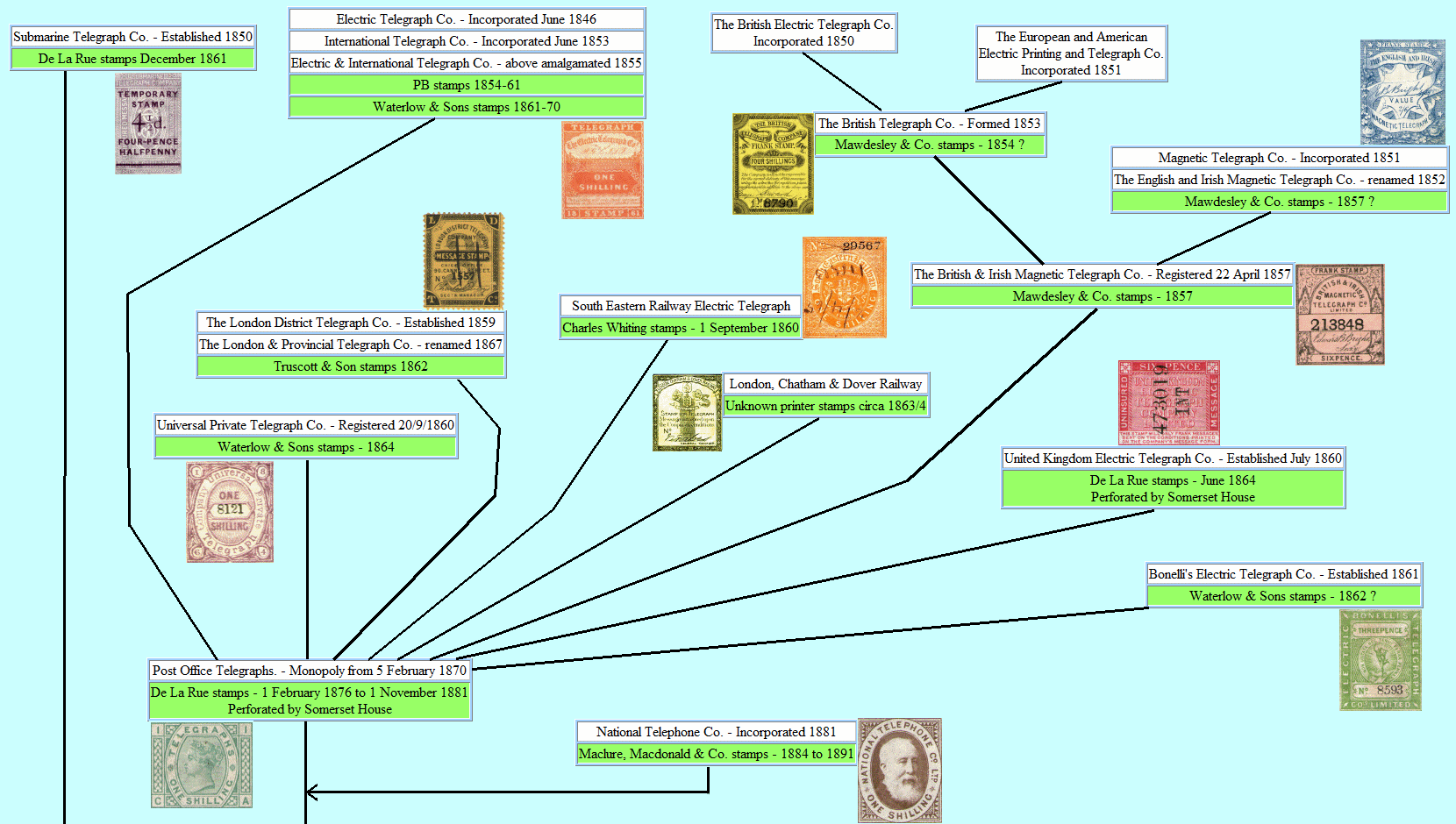 Click on images to go to web-page. |
Partly this is because the Nationalisation of these companies was often met with hostility to the extent of destroying all records.
In some cases facts were distorted, or perhaps evidence created to make companies appear deserving of greater compensation. A lot of money was at stake.
Another problem is that priorities and preconceptions have changed over the years.
A far more extensive family tree of companies, regardless of stamp issuance, can be seen at The BT family tree.
BT plc currently holds many documents relating to the early history of the Telegraph Companies.
An overview of their archives can be seen in this pdf document.
In putting these pages together I have often encountered differences of opinion, contradictions and other anomalies. I try to put these right where I can,
Or simply state the discrepancy where I cannot. In many areas, direct evidence is scarce or non-existent and indirect evidence has to be resorted to.
I have been lucky enough to have now found a number of people who are interested in the subject and both willing and able to supply scans and information.
My heartfelt thanks go out to those people, and more contributions are always welcome.
Presentation card 190 x 240mm dated January 28th 1895, detailing 25 years of progress.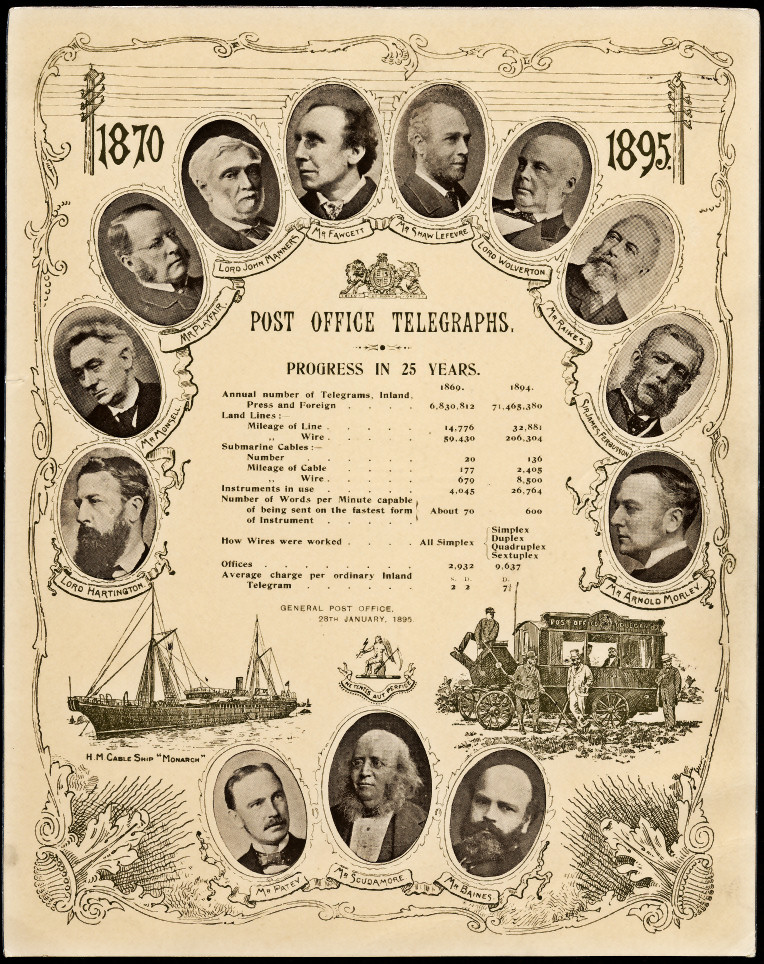 Image, courtesy of Mike-Holt.com |
In comparing the work of different authors one discrepancy I find over and over again is the perforation guage used.
Part of the reason is that material is scarce and writers often just copy information that they are not in a position to check.
Early writers may have seen a few examples and assumed they were all the same. But there is also the point that in the early days it was not considered important.
Langmead & Huggins (Page 8) Referring to the first perforator used on Electric Telegraph Company stamps in 1860 say :-
"The line of perforating pins on the machine was 23 in. long, and owing to the unequal spacing of the pins there can be between 14 and 15½ perforations per 2 cm depending on where the measurement is taken."
The number of perforations per 2 cm is the definition of the units used when quoting the gauge of perforations used for a stamp.
Under circumstances like these it is understandable that an author examining one example may quote Perf. 14 and another with a different example Perf.15
More enlightened later authors may give a range or just an average as their unwritten expectation is that the reader knows it to be highly variable.
Times change, machines improved and the new expectation became accurate quotation of the perforation. The old books, though scarce, are easier to obtain than the stamps.
The first perforating machines were what we call today 'line perforated', that is they simply had one line of perforations so that the sheet of stamps went through the machine twice,
once for the horizontal rows and once for the vertical columns. At the intersection holes did not line up.

GB Postage stamps on the other hand used "Comb-Perforation" where instead of a straight line of holes, the perforator was shaped rather like a comb :

with this, only one pass was needed through the perforator.

and the holes lined up.
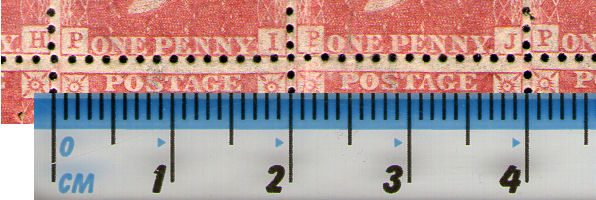
Luckily 2cm is the width of the early GB postage stamps, so you don't need a perforation guage to distinguish between Perf. 16 and Perf. 14, just count them !
More on perforations.
The horizontal guage does not have to be the same as the vertical guage, you can get a "compound perf." of say 14 x 15.
The preparation of the paper for printing can make it rather abrasive. Perforator pins are subject to a lot of wear and can eventually produce some very ragged perforations.
Pins can also break, giving what are called "blind perfs.", see the Bonelli block below. Maintenance can be expensive and also reduces production.
Have a look at the stamps of South Eastern Railway for example, the perforations range from nicely clean-cut on low control-number examples,
to little better than a tear on stamps with a high control-number. Guaging can be problematic.
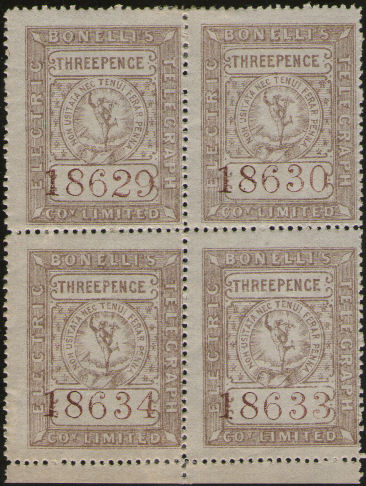
In the early days this may have been nothing, a paper-makers imprint in a corner somewhere or the company name, once covering a sheet.
Many authors may describe a stamp issue as without watermark, whilst another having an example with part watermark will give a different opinion.
Last updated 27th. July 2025
©Copyright Steve Panting 2012/13/14/15/16/17/18/19/20/21/22/23/24/25 except where stated.
Permission is hereby granted to copy material for which the copyright is owned by myself, on condition that any data is not altered and this website is given credit.